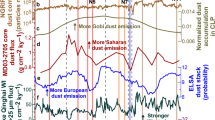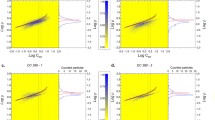Abstract
Ice samples from the 905 m deep Dome C core (East Antarctica) were studied in terms of insoluble microparticle contents. Various techniques were used: right angle light scattering, nephelometer (multiangle light scattering), Coulter counter and microscope analyses, in order to make a thorough study of the physical and optical properties of microparticles and their variations over the last 30000 years. Because of the possible effect of atmospheric turbidity on the earth-atmosphere radiation balance, optical parameters of climatic importance were estimated for insoluble microparticles.
The detailed profile of total microparticle mass concentrations shows a drastic (factor of 17 ± 13) difference between high Last Glacial Maximum (LGM) and low Holocene concentrations. The optical scattering properties of 18000 BP continental dust do not indicate a significant difference with respect to Holocene dust in terms of particle size distribution and complex refractive index. The number to log radius size distribution of microparticles for the entire 30 000 yr period can be fitted by a log-normal distribution with two parameters (modal radius 0.25 ± 0.08 μm; geometric standard deviation 2.2. ± 0.2). However, for the smallest particles a better adjustment between experimental and theoretical scattering diagrams is obtained by adding to the observed size distribution another log-normal distribution (modal radius = 0.025 μm, σ g = 2). The complex refractive index is 1.53 to 1.56 for the real part and 0.005 ± 0.005 for the imaginary part at the wavelength used (λ= 546 nm).
During the LGM stage, over the whole of Antarctica, the change in the total optical depth due to the drastic change in the insoluble aerosol loading is small because insoluble impurities are not the dominant aerosol component. It may have produced a slight warming of the snow surface (≈ 2 K). In the dust source regions, the optical depth would have been a maximum of 2 to 4 times the present value. The possible warming of the atmosphere in these regions is estimated at 3 K per day and should therefore be taken into account in paleoclimate reconstruction models.
Similar content being viewed by others
References
Aitchison, J. and Brown, J. A. C.: 1966, ‘The Log Normal Distribution with a Special Reference to Its Uses in Economies’, Cambridge at The University Press, 176 pp.
Bigg, E. K.: 1980, ‘Comparison of Aerosol at Four Baseline Atmospheric Monitoring Stations’, J. Appl Meteor. 19, 521–533.
Boutron, C.: 1978, ‘Influence des aérosols d'origine naturelle et anthropogénique sur la géochimie des neiges polaires’, Thèse d'Etat, Université Scientifique et Médicale de Grenoble, Pub. N° 254 du Laboratoire de Glaciologie du CNRS, 283 pp.
Boutron, C. and Lorius, C.: 1979, ‘Trace Metals in Antarctic Snows since 1910’, Nature 277, 551–554.
Bowler, J. M.: 1976, ‘Aridity in Australia: Age, Origins and Expression in Eolian Landforms and Sediments’, Earth Sci. Rev. 12, 279–310.
Briat, M., Royer, A., Petit, J. R., and Lorius, C.: 1982, ‘Late Glacial Input of Eolian Continental Dust in the Dome C Ice Core: Additional Evidence from Individual Microparticle Analysis’, Annals of Glaciology 3, 75, 27–31.
Carlson, T. N. and Benjamin, S. G.: 1980, ‘Radiative Heating Rates for Saharan Dust’, J. Atmos. Sci. 37, 193–213.
Carlson, T. N. and Caverly, R. S.: 1977, ‘Radiative Characteristics of Saharan Dust at Solar Wavelengths’, J. Geophys. Res. 21, 3141–3152.
Chylek, P., Grams, G. W., and Pinninck, R. G.: 1976, ‘Light Scattering by Irregular Randomly Oriented Particles’, Science 193, 480–482.
Climap Project Members: 1976, ‘The Surface of the Ice-Age Earth’, Science 191, 4232, 1131–1137.
Coulter Counter, Model TA II, Operation manual, 1975, Coulter Electronics, Inc.- Hialeah, Florida.
Cragin, J. H., Herron, M. M., Langway, C. C. Jr., and Klouda, G.: 1977, ‘Interhemispheric Comparison of Changes in the Composition of Atmospheric Precipitation during the Late Cenozoïc Era’, in Dunhar (ed.), Polar Ocean, 617–631.
Delany, A. N., Pollock, W. H., and Shedlovsky, J. P.: 1973, ‘Tropospheric Aerosol: The Relative Contribution of Marine and Continental Components’, J. Geophys. Res. 78, 27, 6249–6265.
Delmas, R. J., Aristarain, A., and Legrand, M.: 1980a, ‘Acidity of Antarctic Snow: A Natural Reference Level of Acid Rain’, in D. Drabløs and A. Tollans (ed.), Proceed, of an Int. Conference, Sandefjord, Norway, 104–105.
Delmas, R. J., Ascencio, J. M., and Legrand, M.: 1980b, ‘Polar Ice Evidence that Atmospheric CO2 20 000 yr BP was 50% of Present’, Nature 284, 155–157.
Delmas, R. J., Briat, M., and Legrand, M.: 1982a, ‘Chemistry of South Polar Snow’, J. Geophys. Res. 84, 4314–4318.
Delmas, R. J., Barnola, J. M., and Legrand, M.: 1982b, ‘Gas Derived Aerosol in Central Antarctic Snow and Ice: The Case of Sulfuric and Nitric Acids’, Annals of Glaciology 3, 71–76.
Grams, G. W., Blifford, I. H., Gillette, O. A., and Russel, P. B.: 1974, ‘Complex Index of Refraction of Airborne Soil Particles’, J. Appl. Meteor. 13, 459–171.
Hanel, G.: 1968, ‘The Real Part of the Mean Complex Refractive Index and the Mean Density of Samples of Atmospheric Aerosol Particles’, Tellus 20, 371–379.
Hansen, J. E. and Travis, L. D.: 1974, ‘Light Scattering in Planetary Atmosphere’, Space Sci. Rev. 16, 527–610.
Hansen, J. E., Lacis, A. A., Lee, P., and Wang, W.C.: 1980, ‘Climatic Effects of Atmospheric Aerosols’, Annals of the N. Y. Academy of Sci. 338, 375–384.
Herdan, G.: 1960, ‘Small Particle Statistics’, Butterworths, London.
Hodkinson, J. R.: 1963, ‘Light Scattering Extinction by Irregular Particles Larger than the Wavelength’, in Kerner M. (ed.), Proc, of the 2nd interdisciplinary Conf. on electromagnetic scattering, Program Press N.Y.
Hofmann, D. J., Rosen, H. M., and Kierman, J. M.: 1976, ‘Stratospheric Aerosol Measurements, IV: Global Time Variations of the Aerosol-Burden and Source Consideration’, J. Atmos. Sci. 33, 1782–1788.
Holland, A. C. and Draper, J. S.: 1967, ‘Analytical and Experimental Investigation of Light Scattering from Polydispersion of Mie Particles’, J. Appl. Opt. 6, 511–518.
Idso, S. B.: 1981, ‘An Experimental Determination of Radiative Properties and Climatic Consequences of Atmospheric Dust under non Duststorm Conditions’, Atm. Environ. 15, 7, 1251–1259.
Jackson, M. L., Gillette, D. A., Danielsen, E. F., Blifford, I. H., Bryson, R. A., and Syers, J. K.: 1973, ‘Global Dust Fall During the Quaternary as Related to Environments’, Soil Sci. 116, 3, 135–145.
Jouzel, J., Merlivat, L., and Lorius, C.: 1982, ‘Deuterium Excess in East Antarctica Ice Core Suggests Higher Relative Humidity at the Oceanic Surface during the Last Glacial Maximum’, Nature 299, 688–691.
Junge, C. E.: 1963, Air Chemistry and Radioactivity, Academic Press, N.Y., 382 pp.
Junge, C. E.: 1979, ‘The Importance of Mineral Dust as an Atmospheric Constituent’, in C. Morales (ed.), Saharan Dust, 49–60.
Lorius, C., Merlivat, L., Jouzel, J., and Pourchet, M.: 1979, ‘A 30 000 yr Isotope Climatic Record from Antarctic Ice’, Nature 280, 644–648.
Manabe, S. and Wetherald, R. T.: 1975, ‘The Effect of Doubling the CO2 Concentration on the Climate of a General Circulation Model’, J. Atmos. Sci. 32, 3–15.
Mekler, Y., Quenzel, H., Ohring, G., and Marcus, I.: 1977, ‘Relative Atmospheric Aerosol Content from E.R.T.S. Observations’, J. Geophys. Res. 82, 967–970.
Morel, A.: 1973, ‘Diffusion de la lumière par les eaux de mer. Résultats expérimentaux et approche théorique’, Optics of the Sea, Lecture Series N∘ 61, 75 pp.
Morel, A.: 1974, ‘Optical Properties of Pure Water and Pure Sea Water’, in Optical Aspects of Oceanography, Academic Press, N.Y., 1–24.
Parungo, F., Ackerman, E., Caldwell, W., and Weickmann, H. K.: 1979, ‘Individual Particle Analysis of Antarctic Aerosols’, Tellus 31, 521 -529.
Patterson, E. M.: 1981, ‘Optical Properties of the Crustal Aerosol: Relation to Chemical and Physical Characteristics’, J. Geophys. Res. 86, 3236–3248.
Patterson, E. M. and Gillette, D. A.: 1977, ‘Commonalities in Measured Size Distribution for Aerosols Having a Soil-Derived Component’, J. Geophys. Res. 82, 2074–2082.
Petit, J. R.: 1982, ‘Etude des aérosols insoluble déposés dans la neige Antarctique. Contributions à la datation des dépôts glaciares et à la reconstruction du paléoenvironnement atmosphérique’, Thèse d'Etat, Université Scientifique et Médicale de Grenoble, 315 pp, unpublished.
Petit, J. R., Briat, M., and Royer, A.: 1981, ‘Ice Age Aerosol from East Antarctic Ice Core Samples and Past Wind Strength’, Nature 293, 391–394.
Petit, J. R., Jouzel, J., Pourchet, M., and Merlivat, L.: 1982, ‘A Detailed Study of Snow Accumulation and Stable Isotope Content in Dome C (Antarctica)’, J. Geophys. Res. 87, 4301–4308.
Pollack, J. B., Toon, O. B., Sagan, C., Summer, S. A., Baldwin, B., and Van Camp, W.: 1976, ‘Volcanic Explosion and Climate Change: A Theoretical Assessment’, J. Geophys. Res. 81, 1071–1083.
Pourchet, M., Pinglot, J. F., and Lorius, C.: 1979, ‘Some Meteorological Applications from Radioactive Fallout Measurements in Antarctic Snows’, Presented at the IUGG Conference in Canberra, Dec. 1979, (submitted to J. Geophys. Res.).
Rasool, S. I. and Schneider, S. H.: 1971, ‘Atmospheric Carbon Dioxide and Aerosols: Effects of Large Increase on Global Climate’, Science 173, 138–141.
Reck, R. A.: 1975, ‘Aerosols and Polar Temperature Changes’, Science 188, 728–730.
Royer, A.: 1981, ‘Etude des microparticules insolubles contenues dans la neige et la glace Antarctiques par une méthode de diffusion de lumière. Variations temporelles en relation avec le climat’, Thèse 3e cycle de l'Université Scientifique et Médicale de Grenoble, France, 175 pp. (unpublished).
Sarnthein, M.: 1978, ‘Sand Desert During Glacial Maximum and Climatic Optimum’, Nature 272, 43–46.
Shaw, G. E.: 1980, ‘Optical, Chemical and Physical Properties of Aerosols over the Antarctic Ice Sheet’, Atm. Environ. 14, 911–921.
Taylor, S. R.: 1964, ‘Abundance of Chemical Elements in the Continental Crust: A New Table’, Geoch. Cosmoch. Acta 28, 1273–1285.
Thompson, L. G.: 1977, ‘Microparticles, Ice Sheets and Climate’, Institute of Polar Studies, rep. No. 64, 148 pp.
Thompson, L. G., Mosley-Thompson, E., and Petit, J. R.: 1981, ‘Glaciological Interpretation of Microparticle Concentration from the French 905 m Dome C, Antarctica Core’, Proceed. XVII General Assembly, IUGG, Canberra, Australia, Sea Level, Ice and Climatic Change, IAHS Pub. No. 131, 227–234.
Toon, O. B. and Pollack, J. B.: 1976, ‘A Global Model of Atmospheric Aerosol for Radiative Transfer Calculations’, J. Appl. Meteor. 15, 225–246.
Van de Hulst, H. C.: 1957, Light Scattering by Small Particles, Academic Press N.Y. (Wiley ed.), 470 pp.
Volz, F. E.: 1973, ‘Infrared Optical Constants of Ammonium Sulfate, Sahara Dust, Volcanic Pumice and Flyash’, Appl. Optics 12, 3, 564–568.
Wippler, C. and Scheibling, G.: 1954, ‘Description d'un appareil pour l'étude de la diffusion de la lumière’, J. de Chimie Physique 51, 201–205.
Author information
Authors and Affiliations
Rights and permissions
About this article
Cite this article
Royer, A., De Angelis, M. & Petit, J.R. A 30000 year record of physical and optical properties of microparticles from an East Antarctic ice core and implications for paleoclimate reconstruction models. Climatic Change 5, 381–412 (1983). https://doi.org/10.1007/BF00140802
Received:
Revised:
Issue Date:
DOI: https://doi.org/10.1007/BF00140802




